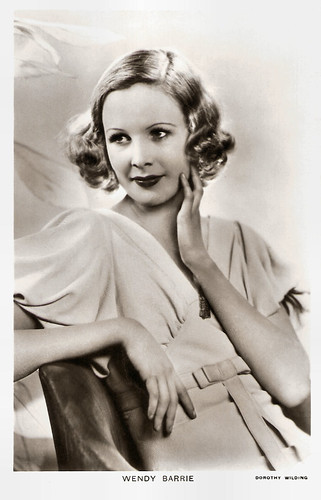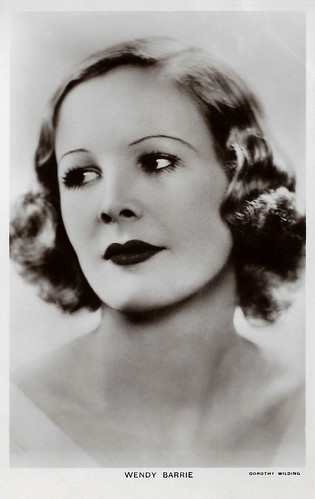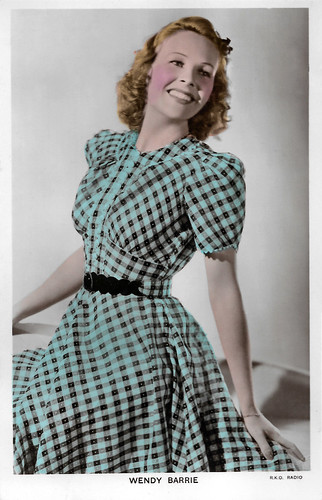
British postcard in the Picturegoer Series, London, no. 730a. Photo: Dorothy Wilding.

British postcard in the Picturegoer Series, London, no. 730. Photo: Dorothy Wilding.
A blonde, vivacious lass with innocent charm and an instinctive acting ability
Wendy Barrie was born Marguerite Wendy Jenkin(s) in 1912 in British Hong Kong, to English parents. Her father, Francis Charles John Graigoe Jenkin(s), was a British lawyer. Her mother was Ellen McDonagh or Sarah Cohen (the sources differ), a Russian-Jewish actress who had performed in the world's first professional Yiddish-language theatre troupe. Her godfather and future stage namesake was the Scottish novelist-playwright, Sir J.M. Barrie, in whose play 'Peter Pan' was a character called Wendy.
She received her education at a convent school in England and a finishing school in Switzerland. As a teenager, she began pursuing a career as an actress, helped by her red-gold hair and blue eyes. She adopted the stage name Wendy Barrie and played at the London Savoy Theatre in 'Wonder Bar' (1930). In 1932, she made her film debut in the British drama Threads (G.B. Samuelson, 1932).
She was then signed to make several motion pictures for London Films under the Korda brothers, Zoltan Korda and Alexander Korda. She soon had her first major success with her role as Jane Seymour, the third of the six wives of King Henry VIII of England in The Private Life of Henry VIII (Alexander Korda, 1933) alongside Charles Laughton and Merle Oberon. The film was a major international success, establishing Korda as a leading filmmaker and Laughton as a box-office star.
Hollywood soon also beckoned for Barrie. In 1934, she went to America where Fox signed her. During the next decade, she found regular employment at Paramount (1935), Universal (1936-1938) and RKO (1938-1942). I.S. Mowis at IMDb: "A blonde, vivacious lass with a certain innocent charm and an instinctive acting ability, she tended to play mostly ingenue roles in minor films and often rose above her material." Her American film debut was the screwball comedy It's a Small World (Irving Cummings, 1934) in which she co-starred with Spencer Tracy. It was followed by the romantic comedy Under Your Spell (Otto Preminger, 1936) with opera baritone Lawrence Tibbett. In 1936 she was loaned to MGM and played in Speed (Edwin L. Marin, 1936) alongside James Stewart in his first starring role.
Barrie starred alongside Humphrey Bogart in the social drama Dead End (William Wyler, 1937). Two years later, the Sherlock Holmes classic The Hound of the Baskervilles (Sidney Lanfield, 1939) followed, in which she played the female lead alongside Basil Rathbone and Richard Greene. Craig Butler at AllMovie: "The first of the long and successful series of Basil Rathbone Sherlock Holmes films, The Hound of the Baskervilles is smashing good fun for Holmes enthusiasts and fans of the detective thriller genre. Set in the appropriately spooky moors, Hound is an engaging adaptation of the Arthur Conan Doyle original -- respectful but not slavish, and unafraid to make changes to make the film more interesting cinematically." She co-starred with Lucille Ball in the melodrama Five Came Back (John Farrow, 1939). Her Hollywood career alternated between leads in B movies and supporting roles in bigger films.

British postcard in the Colourgraph Series, London, no. C 189. Photo: Dorothy Wilding.

British postcard in the Colourgraph Series, London, no. C 355. Photo: R.K.O. Radio.
Engaged to infamous gangster Bugsy Siegel
During 1939 and the early 1940s, Wendy Barrie made several of The Saint and The Falcon mystery films with George Sanders. At the end of the 1930s, she was a member of the cast of The Jack Haley Show on NBC (1937-1938) and CBS (1938-1939). She became a naturalised American citizen in 1942 and was attired in the uniform of the women's ambulance and transport corps.
In the 1940s, Wendy Barrie focused on radio and television. She was an assistant on the Star for a Night radio program on the Blue Network (1943-1944), and she was one of the quizmasters on Detect and Collect on CBS (1945) and ABC (1945-1946). In 1956, she had a disc jockey program, the Wendy Barrie Show, on WMGM in New York City. She also hosted a widely syndicated radio interview show into the mid-1960s.
She only acted occasionally in television programs, such as in the children's comedy The Adventures of Oky Doky (1948) featuring a cowboy puppet. In the same year, she decided to embark on what turned out to be a successful new career as television host of her pioneering talk show on daytime television, Picture This (1948), followed by The Wendy Barry Show (1948-1950). Her trademark sign-off was "Be a good bunny".
Her relaxed, informal style brought her great popularity and plaudits from television critics like Jack Gould of the New York Times. That program was replaced by Through Wendy's Window in August 1950. The 15-minute NBC program had Barrie interviewing celebrities and talking about fashions. She continued appearing on network television on panel shows in the early 1950s and as a spokesperson for commercial products, including a stint as the original Revlon saleswoman on The $64,000 Question. In 1950, she performed as a substitute for Jean Arthur in 'Peter Pan', along with Boris Karloff, at the Imperial Theatre, in New York City.
Her last film was the comedy It Should Happen to You (George Cukor, 1954) with Judy Holliday. In 1962, Wendy Barrie stopped acting. In the mid-1970s, she suffered a stroke which affected her mental state and she spent the last years of her life at a nursing home in Englewood, New Jersey. There she died in 1978 at the age of 65. She is buried at the Kensico Cemetery in Valhalla, New York. Wendy Barrie has a star on the Hollywood Walk of Fame (1708 Vine Street). Wendy Barrie was reportedly engaged to and had a daughter named Carolyn with the infamous gangster Benjamin 'Bugsy' Siegel. Later, she was married to textile manufacturer David L. Meyer.

British postcard by Film Weekly, London.

British postcard in the Picturegoer Series, London, no. 730c. Photo: Paramount.
Sources: I.S. Mowis (IMDb), Craig Butler (AllMovie), Hollywood Walk of Fame, Wikipedia (Dutch, German and English) and IMDb.
No comments:
Post a Comment